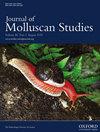英国下侏罗世虾虎鱼科(双壳类)的修订
IF 1.2
4区 生物学
Q2 MARINE & FRESHWATER BIOLOGY
引用次数: 0
摘要
双壳纲(Astartidae)是英国下侏罗世常见的底栖化石,因此了解它们的分类学非常重要,这样才能将它们作为一个研究系统来考虑这一时代的环境变化和灭绝事件。英国下侏罗世的大多数芒星鱼科物种都属于芒星鱼亚科,包括 Neocrassina 属、Coelastarte 属和 Oxyeurax 属。由于归属于 Neocrassina 属的两个物种具有一些非典型特征,人们对这些归属于 Neocrassina 属的贝壳是否可以进一步拆分产生了一些疑问。我们倾向于将这些非典型物种保留在与它们亲缘关系最密切的 Neocrassina 属中,而不是另立一个属。本研究将英国下侏罗世化石双壳类中被归入 Nicaniella 的一组双壳类归入 Oxyeurax,其依据是存在定义不清的 3a 齿和副脊装饰的形式。Astartinae在物种水平上的分化是复杂的;与其他双壳类相比,该亚科表现出普遍较低的差异,再加上非形态学的影响,在某些情况下还会出现性二型。我们的研究表明,在下侏罗世,Neocrassina 品系的形状、铰链板的发育和复杂性都发生了渐变,并确定了 Oxyeurax 物种的潜在性二态性。时间上重叠的 Oxyeurax 物种显示出不同程度的观赏发育,这很可能是受环境控制的,本研究利用它们来定义不同的新物种。本研究确认了英国下侏罗世的 12 个不同的芒星科(Astartinae)物种。其中 9 个是已确定的类群(Neocrassina elegans、N. expansa、N. gueuxii、N. lurida、N. phaedra、?N. camertonensis、?N. dentilabrum、Oxyeurax duplicata、O. striatosulcata),3 个是新种(Coelastarte wardenensis、O. mickletonensis 和 Oxyeurax thompsoni)。在英国侏罗纪下统的天星科物种中,只有两个物种在全球早托卡斯灭绝事件中幸存下来,其中一个是Neocrassina,另一个是Oxyeurax。然而,托尔克世早期缺乏化石丰富、高能量的近岸环境可能会影响这一观察结果,尤其是对 Oxyeurax 而言。本文章由计算机程序翻译,如有差异,请以英文原文为准。
Revision of the British Lower Jurassic Astartinae (Bivalvia)
The Astartidae (Bivalvia) are a common benthic fossil in the British Lower Jurassic and as such it is important to understand their taxonomy so as to use them as a study system with which to consider environmental change through, and extinction events in, this epoch. The majority of the species of the Astartidae from the British Lower Jurassic are taxa within the subfamily Astartinae, encompassing the genera Neocrassina, Coelastarte and Oxyeurax. There has been some question as to whether those shells attributed to Neocrassina could be further split, with two species assigned to this genus having some characters that are atypical. We prefer to retain the atypical species within ?Neocrassina, the genus with which they have the greatest affinity, rather than erect another genus. This study assigns the suite of British Lower Jurassic fossil bivalves attributed to Nicaniella to Oxyeurax, based on the presence of a poorly defined 3a tooth and form of commarginal ridge ornament. Differentiation at the species level in Astartinae is complicated; the subfamily exhibits generally low disparity compared with other bivalves, compounded by ecomorphological effects and, in some cases, sexual dimorphism. We show that the Neocrassina lineage exhibits gradual changes in shape, as well as hinge plate development and complexity, through the Lower Jurassic, and identify potential sexual dimorphism in species of Oxyeurax. The temporally overlapping species of Oxyeurax display varying degrees of ornamental development which may well be environmentally controlled and are used in this study to define distinct new species. This study recognizes 12 distinct species of Astartinae from the British Lower Jurassic. Nine are established taxa (Neocrassina elegans, N. expansa, N. gueuxii, N. lurida, N. phaedra, ?N. camertonensis, ?N. dentilabrum, Oxyeurax duplicata, O. striatosulcata), whilstthree are new species (Coelastarte wardenensis, O. mickletonensis and Oxyeurax thompsoni). Only two of the British Lower Jurassic Astartinae species appear to have survived the global Early Toarcian extinction event as represented in British successions; one Neocrassina and one Oxyeurax. However, the lack of fossiliferous, high energy near shore environments in the early Toarcian may bias this observation, especially for Oxyeurax.
求助全文
通过发布文献求助,成功后即可免费获取论文全文。
去求助
来源期刊

Journal of Molluscan Studies
生物-动物学
CiteScore
3.00
自引率
8.30%
发文量
36
审稿时长
3 months
期刊介绍:
The Journal of Molluscan Studies accepts papers on all aspects of the study of molluscs. These include systematics, molecular genetics, palaeontology, ecology, evolution, and physiology. Where the topic is in a specialized field (e.g. parasitology, neurobiology, biochemistry, molecular biology), submissions will still be accepted as long as the mollusc is the principal focus of the study, and not incidental or simply a convenient experimental animal. Papers with a focus on fisheries biology, aquaculture, and control of molluscan pests will be accepted only if they include significant advances in molluscan biology. While systematic papers are encouraged, descriptions of single new taxa will only be considered if they include some ‘added value’, for example in the form of new information on anatomy or distribution, or if they are presented in the context of a systematic revision or phylogenetic analysis of the group.
 求助内容:
求助内容: 应助结果提醒方式:
应助结果提醒方式:


